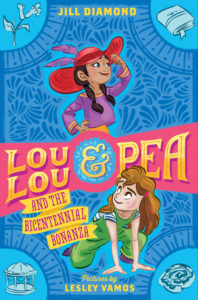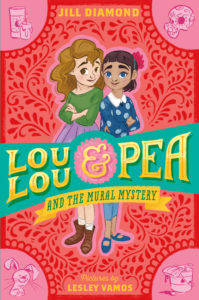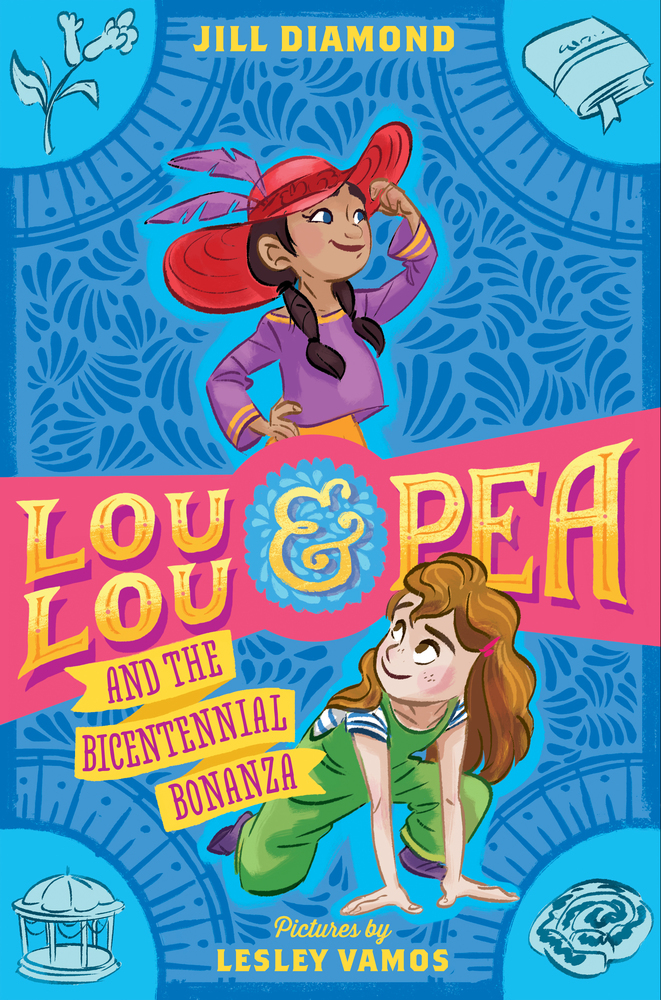craft review by Kristi Wright
As a middle grade writer of contemporary fantasies and futuristic adventures, I’m always interested in honing my world-building skills. At the 2018 SCBWI LA conference, Malinda Lo discussed five foundations of world-building, which she also documented in a blog post. While these guidelines are geared toward writers of fantasy and science fiction, they are an excellent guide for people writing contemporary fiction as well, especially those who are creating fictional settings for their modern-day stories.
Jill Diamo nd’s Lou Lou and Pea books, Lou Lou and Pea and the Mural Mystery and Lou Lou and Pea and the Bicentennial Bonanza, explore a vibrant fictional neighborhood: “Although they lived in a city, their little neighborhood was close-knit like a small town. It was called El Corazón, because it was in the heart of the city and alive with culture and art.” (Mural Mystery, pg 12).Readers get to know the neighborhood of El Corazón from the title characters’ perspectives, as they explore and live in their world. (Check out our interview with Jill Diamond, and watch for another interview post coming soon!)
nd’s Lou Lou and Pea books, Lou Lou and Pea and the Mural Mystery and Lou Lou and Pea and the Bicentennial Bonanza, explore a vibrant fictional neighborhood: “Although they lived in a city, their little neighborhood was close-knit like a small town. It was called El Corazón, because it was in the heart of the city and alive with culture and art.” (Mural Mystery, pg 12).Readers get to know the neighborhood of El Corazón from the title characters’ perspectives, as they explore and live in their world. (Check out our interview with Jill Diamond, and watch for another interview post coming soon!)
Place
One of Lo’s world-building foundations is PLACE, and she recommends getting personal and specific to create a three-dimensional reading experience. In Diamond’s first Lou Lou and Pea story, she focuses her spotlight exclusively on this close-knit neighborhood of El Corazón. The neighborhood comes alive through a variety of very specific details.
In the opening chapter, Diamond gives Lou Lou and Pea an errand they must do that takes them on a visual tour of the neighborhood.
“On the way to Sparkle ‘N Clean, Lou Lou and Pea admired things they loved about their neighborhood, from Mrs. Thompson’s wooden lawn flamingos to the shiny red-and-black vintage cars that were meticulously maintained by Mr. Martinez.” (Mural Mystery, pg 13)
Their errand takes them to the local laundry, which is also a charming fashion boutique with all sorts of treasures–brooches, opera gloves, boas. From there, they go to the local candle shop because the owner is good at fixing problems, which Lou Lou and Pea already have! We learn that it’s “nestled between Manny’s Bodega and Chilly Refrigerator Repair” (Mural Mystery, pg 18).
 Each new place they visit has well-rounded characters that showcase the neighborhood’s sense of community. When Lou Lou and Pea leave the candle shop, they take a different route home, which allows them to see “El Corazón’s dazzling community-created murals” (Mural Mystery, pg 26). The murals play a huge role in the first Lou Lou and Pea story.
Each new place they visit has well-rounded characters that showcase the neighborhood’s sense of community. When Lou Lou and Pea leave the candle shop, they take a different route home, which allows them to see “El Corazón’s dazzling community-created murals” (Mural Mystery, pg 26). The murals play a huge role in the first Lou Lou and Pea story.
Diamond pays similar attention to the various homes in the story. Each one perfectly complements the characters who live there. For example:
“Lou Lou’s home reflected her dad’s passion for ships at sea, which Peter Bombay had inherited from a long line of Bombay sailors. The exterior was boat shaped and painted a shiny red with white trim around the porthole windows. Above the front door was a carved wooden mermaid figurehead that Lou Lou had named Serena.” (Mural Mystery, pg 33)
Diamond’s charming mom-and-pop neighborhood stores immediately give us the warm and cozy feeling that this is a safe environment for Lou Lou and Pea to wander about in. Everyone is looking out for each other. There’s a timelessness that transcends any particular era, though we know this is a contemporary setting.
In Lou Lou and Pea and the Bicentennial Bonanza, Diamond both adds to the neighborhood charm with new stores like Marvelous Millinery (where Pea is an apprentice) and widens the lens to incorporate the entire city. Once again, Diamond immediately sends Lou Lou and Pea on an errand, which gives them an opportunity to enjoy “the sights and smells of their neighborhood”:
“‘Mmm, fresh tortillas,’ Lou Lou said as they passed the Castillos’ house and got a whiff of dinner preparations.” (Bicentennial Bonanza, pg 9)
In Bicentennial Bonanza, we are introduced to additional neighborhoods, such as Verde Valley, Dove Heights, and Centro Circle. Some of the book takes place in rival Verde Valley and this adds to the story’s rich world-building.
“It was only a ten-minute drive to La Fuente Park, a large square of grass in the center of Verde Valley that was only slightly smaller than Limonero Park. La Fuente Park didn’t have Limonero Park’s beautiful lemon trees, but it was still lovely with its laurel trees filled with birds and a rose garden that Lou Lou had always admired.” (Bicentennial Bonanza, pg 204)
We are convinced Diamond is writing about a real city, especially because she uses other important world-building devices to bring even more substance to her fictional world.
Action: Take a look at your work-in-progress and see how you can be more specific and personal with your place (setting) to ground your readers in your world, whether fantastical or realistic.
Rituals
Another world-building foundation that Lo discusses in her blog post is the idea of RITUALS that move individuals from one state to another: “A ritual experience is an excellent way to show your world’s cultural depth and traditions.”
Perhaps even more than place, Diamond uses ritual as the keystone for her Lou Lou and Pea stories. In Lou Lou and Pea and the Mural Mystery, we discover that
“Lou Lou and Pea never missed a special occasion. Birthdays were celebrated with fancy dresses and pineapple pizza. On Valentine’s Day, they made gigantic paper hearts and taped them to the front doors of friends and neighbors. Last year, they’d even remembered Flag Day and decided to sew their own flag–a combination of American, Mexican, and pirate–for Lou Lou’s home.” (Mural Mystery, pg 28)
The two friends are all about ritual. Every Friday, they celebrate PSPP (Post-School-Pre-Parents) by drinking tea and eating scones and talking about their day and week. It was “a glorious hour and twenty-three minutes of Lou Lou’s Friday” (Mural Mystery, pg 4).
In Diamond’s first book, rituals that play key roles include: a quinceañera, the Hello Horticulture! Society Annual Conference, a funeral for a particular camellia named Pinky that should have won first place in the Flowering Bushes and Shrubs competition at the horticulture conference, and of course, Día de los Muertos, a special cultural celebration.
The second Lou Lou and Pea book centers exclusively around one ritual–the Bicentennial Bonanza–which is their city’s huge two hundredth birthday bash. Both Lou Lou and Pea are playing a big role in the celebration.
“‘I can’t wait for the Bonanza,’ said Lou Lou. ‘It’s going to be so much fun, and we’re going to be even famouser once everyone sees my beautiful honeysuckle and your amazing hats!’” (Bicentennial Bonanza, pg 7)
Action: Consider whether you can add a ritual or even more than one into your story–something specific to the characters like a PSPP, or something specific to their world like El Corazón’s Día de los Muertos celebration, or even something your story can revolve around, like the Bicentennial Bonanza.
Power
Lo identifies POWER as a third foundational element of world building. She recommends that you always be aware of who is powerful and who is weak in your world. This element becomes important in Diamond’s Bicentennial Bonanza because a primary antagonist is the vice-mayor of Lou Lou and Pea’s fictional city (the mayor is away due to a family emergency). Lou Lou and Pea have to find a way to save their Bonanza, despite being pitted against one of the most powerful people in their small world.
When they question the vice-mayor’s decision to move the Bicentennial Bonanza to a different neighborhood in their city, his response shows that he knows he has all the power:
“‘Because I say so and I’m the vice-mayor!” boomed Andy Argyle. “But if you don’t trust me, you can come to the City Archives in City Hall and I will show it to you myself.’ It seemed like he had an answer for everything.” (Bicentennial Bonanza, pg 66)
ACTION: Look at your world and see how you can introduce a power hierarchy that might affect your MC’s ability to attain her goals.
Food
Lo also encourages authors to use FOOD as a shorthand for their world-building and this is another foundational element that Diamond hits out of the park. Throughout both books in the series, she uses food to cement her readers’ understanding of this charming world she’s created, whether it’s tea and scones during a PSPP meeting, a local restaurant’s famous chocolate cheesecake, or Lou Lou’s dad’s landlubber lasagna.
But the second story goes all in on its use of food as part of world building by including a caracoles contest as part of the Bonanza celebration. Throughout the story a secondary plot is Lou Lou and Pea’s friend Jeremy’s attempts to create the perfect caracol (the city’s signature pastry).
“It was a long length of flaky sweet dough wound into the shape of a snail. In the center of the caracol’s doughy shell was a little well of custardy cream. This was Lou Lou’s favorite part, and she usually licked out the cream before eating the rest. But this time, she bit straight into the dough, taking her role as a taste tester very seriously.” (Bicentennial Bonanza, pg 26)
ACTION: Look for opportunities to add specific foods into your work-in-progress that bring more dimension to your world.
Rules (for Sci-Fi/Fantasy)
Lo’s final world building foundational element is RULES and this one is very specific to a world that has magic or science that is beyond that of our world. In this case, she encourages authors to set logical rules for how magic or science works, and then stick to them. Diamond’s series doesn’t require this foundation to bring its contemporary world to life.
ACTION for fantasy/sci-fi writers: Write down the rules that your fantasy and science should adhere to and then check your story for consistency.
The Lou Lou and Pea series by Jill Diamond is an excellent example of deft world building. It immerses its readers in a fully dimensional neighborhood that is charming and timeless. Whether you write contemporary middle grade novels or fantasy/sci-fi, think about what techniques you can use to make your world the most compelling it can be.
Kristi Wright (co-editor) writes picture books and middle grade novels. Her goal as a writer is to give children a sense of wonder, a hopefulness about humanity, and a belief in their future. She is represented by Kurestin Armada at Root Literary. She is an active volunteer for SCBWI and a 12 X 12 member. Find her at www.kristiwrightauthor.com and on Twitter @KristiWrite.


excellent post! thank you!